SALD-HC Series - Features
High-Concentration Sample Measurement System
Measurement of High Concentrations Achieved Using Laser Diffraction/Scattering
- This system can measure the particle size distribution of high-concentration samples that up till now could not be measured using previous laser diffraction/scattering methods.
- You can expect more accurate measurement of even samples, whose particle distribution changes by dilution, since the sample can be measured in its original state or with only the minimum required level of dilution.
- Commercially-available hand creams, face creams and hair conditioners can be measured with hardly any pretreatment.
No Complex Parameter Settings Required
- Unlike methods that use ultrasonic waves, this method does not require calibration.
- Complex parameters related to the properties of the measurement target need not be set.
- The refractive index is the only item that needs setting.
Measurement Possible with Very Small Amounts of Sample
- Measurement is possible with very small amounts of sample.
- Valuable samples can be measured with very little wastage.
- Example of Measurement Data
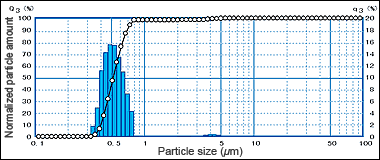
Particle Size Distribution of W/O Emulsion
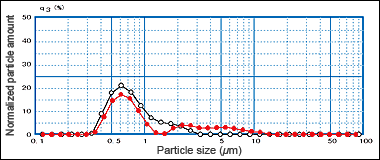
Particle Size Distribution of 2 Types of Can Coffees with Different Storage Conditions
Notes
- There are greater restrictions on the measurement range for a high-concentration sample measurement system than there are for standard wet measurement (when using a flow cell or batch cell). Basically, the range is narrower.
- As a rough guide, measurement is possible for concentrations of up to approx. 20 wt%. Depending on the sample substance, particle size and particle size distribution, however, there are cases where measurement is difficult at concentrations of approx. 10 wt%.
- Samples with wide distribution widths are more likely to be affected by multiple scattering than samples with narrow distribution widths, and it may not be possible to obtain accurate measurements in some cases.
* Appearance and specifications are subject to change without notice.
Principle of High-Concentration Sample Measurement by the Laser Diffraction/Scattering Method
- The laser diffraction/scattering method is the mainstream means used for measuring particle size distribution.
- The basic approach to this method is exactly the same as measurement using a regular flow cell and batch cell.
- The sample is held between two thin sheets of glass (glass slides), and laser light is irradiated on the sample to measure its particle size distribution.
Principle of Measurement
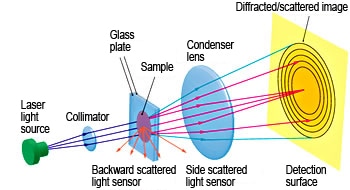
If a standard flow cell or batch cell is used to measure a sample at a high concentration, the long light path results in multiple scattering and this makes it impossible to obtain accurate measurements.
Measurement is possible by simply holding the high-concentration sample particles to be measured between two glass slides. This significantly shortens the length of the light path, avoids the negative effects of multiple scattering and makes accurate measurement possible.
Shortening the light path to avoid multiple scattering
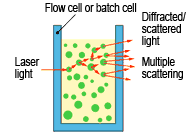
Measurement with a Standard Flow Cell or Batch Cell
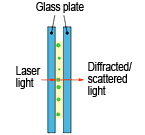
Sample Held between Two Glass Slides
Detection of side scattered light
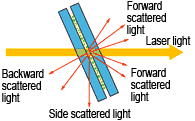
Also, placing the sample so that it is diagonal to the optical axis makes it possible to detect side scattered light.
Applying particle size calculations to this and also to forward and back scattered light enables measurement of high-concentration samples in sub-micron region. (Side and back sensors are not available for the SALD-300V and SALD-200V ER.)
* Appearance and specifications are subject to change without notice.


